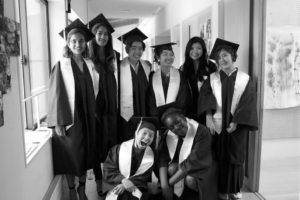
“Billions of Asians growing up in the past two decades have experienced geopolitical stability, rapidly expanding prosperity, and surging national pride. The world they know is not of Western dominance but of Asian ascendance.” Parag Khanna
In recent years, Asia has emerged as a powerhouse in the realm of higher education, attracting students from all corners of the globe to its world-class academic institutions. Countries such as Singapore, South Korea, Japan, and China have cemented their positions as top destinations for international students seeking quality education, cultural enrichment, and unparalleled academic experiences. In this article, we explore the factors driving Asia’s ascent as a premier academic hub and why students are increasingly flocking to these dynamic and culturally rich nations.
Singapore: The Lion City's Academic Excellence
Singapore has positioned itself as a leading educational hub in Asia, boasting a vibrant multicultural environment and a reputation for academic excellence. Home to renowned universities such as the National University of Singapore (NUS) and Nanyang Technological University (NTU), Singapore offers a wide range of programs across various disciplines, from business and engineering to the arts and sciences. With state-of-the-art facilities, innovative teaching methods, and a focus on research and innovation, Singapore provides students with a world-class education that prepares them for success in the global arena.
Furthermore, Singapore’s education system is designed to be inclusive, integrating students from various cultural backgrounds and fostering a global perspective. This holistic approach ensures that graduates are not only academically proficient but also culturally adept and ready to thrive in an interconnected world. In recent years, the number of international students in Singapore has fluctuated, with about 59,000 students reported as of August 2021. The origins of these students are diverse, reflecting Singapore’s multicultural environment, with a history of high achievement scores among immigrant students. This vibrant educational landscape offers a unique blend of cultural and academic experiences for students from around the world.
Admission requirements for international students in Singapore universities typically include having completed high school with at least 12 years of general education. Prospective students must provide proof of their qualifications, which can vary from A-Levels, American High School Diploma, to other international equivalents. Additionally, proof of English proficiency through tests like IELTS or TOEFL is often required, especially for non-native speakers. Each university may have specific prerequisites for different programs, so it’s advisable to check the individual university’s admission guidelines for detailed information.
Tuition fees for international students in Singapore vary widely depending on the chosen institution and program. For the 2022 intake, the cost was around US$26,000 per year, but this can significantly differ based on the university and course. It’s important for students to consider not only tuition but also living expenses, which can range from SG$900 to SG$2,000 monthly. Prospective students should check specific university websites for the most accurate and up-to-date fee structures.
South Korea: Where Tradition Meets Innovation
South Korea’s rise as an academic powerhouse is fueled by its unique blend of tradition and innovation. South Korea is home to several prestigious universities known for their academic excellence and innovative research. Seoul National University, KAIST, Yonsei University, Korea University, and Sungkyunkwan University are often ranked among the top institutions. These universities offer a wide range of programs and have a strong international presence, attracting students and scholars from around the globe. South Korea offers students a dynamic learning environment coupled with cutting-edge research opportunities. From K-pop to technology, South Korea is at the forefront of global trends, making it an exciting destination for students looking to immerse themselves in a culture that seamlessly integrates tradition with modernity.
In 2023, South Korea hosted approximately 180,000 international students, a significant increase from the previous decade. The majority of these students hailed from China and Vietnam, with Chinese students comprising 32.1% and Vietnamese students 37.6% of the international student population. This diverse influx of students reflects South Korea’s growing appeal as an educational hub in Asia.
Admission requirements for top universities in South Korea typically include a high school diploma or equivalent for undergraduate programs, and a completed bachelor’s degree for graduate studies. Prospective students may need to provide standardized test scores such as SAT, ACT, or the Korean College Scholastic Ability Test (CSAT). Additionally, proof of proficiency in Korean or English, such as TOPIK, TOEFL, or IELTS scores, is often required. Universities also look for letters of recommendation, essays or personal statements, and may conduct personal interviews with applicants.
Japan: A Land of Endless Possibilities
Japan has become a popular destination for international students, with a diverse student population from various countries. According to the latest statistics, there were 242,444 international students in Japan. The majority of these students are enrolled in social sciences, and a significant number pursue undergraduate studies or attend colleges of technology. The data also indicates a fluctuation in numbers over the years, often influenced by global events such as the COVID-19 pandemic. Students come from all over the world, with a notable number from neighboring Asian countries, contributing to the rich cultural tapestry of Japan’s academic environment.
The University of Tokyo, often referred to as Todai, is a prestigious institution that is highly sought after by international students. It is renowned for its academic excellence and extensive research facilities. Kyoto University is another top choice, known for its historic campuses and high academic standards. Other popular universities include Osaka University, Tohoku University, and Keio University, each offering a unique blend of traditional Japanese culture and modern educational practices. These universities not only provide quality education but also support international students through various programs and services.
Admission requirements for international students in Japanese universities typically include passing the Examination for Japanese University Admission for International Students (EJU), which assesses Japanese language skills and basic academic abilities. Additionally, students may need to demonstrate financial stability and provide recommendation letters, academic transcripts, a valid passport, and passport photos. Specific requirements can vary by institution, so it’s advisable to check the individual university’s guidelines for detailed information.
The cost of studying in Japan for international students varies depending on the institution and level of study. For undergraduate programs, tuition fees generally range from approximately 820,000 yen to 900,000 yen per year, which includes admission fees. For graduate studies, the costs are about 800,000 yen to 1,000,000 yen for master’s programs and 680,000 yen to 1,100,000 yen for doctoral programs. It’s important to note that these figures can fluctuate and additional expenses such as living costs, textbooks, and other educational materials may apply.
China: The Dragon's Roar in Higher Education
China’s rapid economic growth and investment in education have catapulted it to the forefront of global higher education. Boasting top-ranked institutions such as Tsinghua University, Peking University, and Fudan University, China offers students a diverse array of academic programs and research opportunities. With a booming economy, rich cultural heritage, and a rapidly expanding higher education sector, China presents students with boundless opportunities for learning, growth, and exploration.
In 2018, China hosted 492,185 international students from various countries, marking a slight increase from the previous year. The majority of these students originated from Asia, with South Korea leading the list, followed by other countries such as Thailand, Pakistan, India, and the United States. Beijing and Shanghai were the top cities hosting the highest numbers of international students. This diverse influx reflects China’s growing reputation as a destination for higher education.
International students in China gravitate towards a variety of fields, with some of the most popular being Clinical Medicine, International Economics and Trade, Computer Science and Technology, Business Administration, and Engineering disciplines such as Civil and Mechanical Engineering. These fields align with the global demand for professionals in healthcare, economics, technology, and infrastructure development, reflecting China’s educational offerings in areas of rapid growth and international interest.
International students looking to study in China need to meet certain requirements. Firstly, they must hold a valid passport and obtain a student or visitor visa. Universities require proof of qualifications, financial stability, and a guarantor in China. Additionally, a clean criminal record is necessary, verified by a certificate notarized by a Chinese embassy. English proficiency is also a key requirement for programs taught in English, which can be demonstrated through tests like IELTS, TOEFL, or Duolingo English Test.
The cost of studying in China for international students can vary widely depending on the chosen program and city. On average, tuition fees for undergraduate programs range from $3,000 to $10,000 per year, while postgraduate programs may cost between $5,000 to $20,000 annually. Living expenses also differ by location, but China is known for its relatively low cost of living compared to many Western countries. Prospective students should consider both tuition and living costs when budgeting for their studies in China. For a more detailed breakdown, it’s advisable to use a cost calculator or consult specific university guidelines.
As Asia continues to rise as a global academic hub, students are increasingly drawn to the region’s diverse offerings, innovative learning environments, and rich cultural experiences. Whether in Singapore, South Korea, Japan, or China, students have access to world-class education, cutting-edge research opportunities, and a vibrant multicultural community that prepares them for success in an increasingly interconnected world. With Asia’s star on the rise, the future of higher education is undoubtedly bright in the region.
At Ahanda Global Education, we understand the allure of studying in Asia’s top academic destinations and are committed to helping students navigate the application process with ease. Whether you’re considering Singapore, South Korea, Japan, or China for your higher education journey, our team of experienced academic coaches is here to provide personalized guidance and support every step of the way. From crafting compelling application essays to navigating visa requirements and securing scholarships, we’ll work closely with you to ensure a smooth and successful transition to your chosen destination. With our expertise and dedication to your academic success, you can embark on your international education adventure with confidence. Contact us today to learn more about how we can help you realize your dreams of studying in Asia’s premier academic hubs.
To learn more:
- 한국유학종합시스템(스터디인코리아) Study in Korea|run by Korean Government
- Ministry of Foreign Affairs Singapore – Studying in Singapore
- Study in Japan Official Website
- 留学中国网 (studyinchina.edu.cn)
- 5 Reasons Why Singapore Is Asia’s Premier Education Hub
- Top 12 Reasons why you should study in Asia in 2023
- Will East Asia become a regional higher education hub? | Times Higher Education
- Hubs to Take Elite Chinese Universities Into World-class Club | Study In China
- “Education fever”: Changing international study trends in South Korea
- Studying in South Korea: The University System Explained – BridgeU
- Why the future is Asian: An interview with Parag Khanna | McKinsey
- The East Asian tech hub: K-college the latest rage in K-pop Krazy Gen Z universe – The Economic Times



